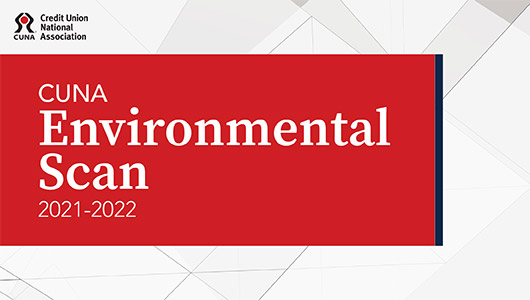
Strategic planning: Four trends to watch
Addressing cybersecurity and developing an agile workforce will be key for future success.
When it’s time for your next strategic planning session, what will be on the agenda when preparing for your credit union’s future?
The 2021-2022 CUNA Environmental Scan explores trends shaping the future of the credit union industry and provides insights that will allow credit unions to make intelligent decisions.
Here are four of those trends:
1. Financial well-being for all
The credit union movement operates under a significant and growing threat of changes to its tax status and regulatory reforms that could greatly impede its ability to serve members.
Meeting these challenges head-on will require a movement-wide commitment to both better communicate what we do for our members and better measure the impact we have on members’ lives.
Collectively, we need to do this more often, more consistently, and with more detail. That’s important today—but it will be even more important in the coming months and years.
“Credit unions care deeply about members’ financial situations and money choices. We strive to provide all with financial security and freedom of choice,” says Mike Schenk, CUNA’s chief economist and deputy chief advocacy officer. “Financial well-being is at the heart of credit union mission and structure.”
2. IT security: CISOs, ransomware, and people power
The past year saw credit unions addressing new cybersecurity challenges created by the coronavirus (COVID-19) pandemic realities of remote work, closed branch lobbies, and skyrocketing adoption of digital channels and tools.
The pressure continues to build in more established problem areas: the prospect of litigation, a shortage of qualified cybersecurity talent, and oversight of how vendors and partners are protecting and using credit union data.
Virtually every credit union process has a cyber component, emphasizing the importance of cybersecurity in decision-making and strategy.
“Cybersecurity concerns are here to stay,” says Carlos Molina, senior risk consultant with CUNA Mutual Group. “There’s no foolproof way to prevent these attacks from occurring, but you can minimize the risks with the right information technology security and risk management procedures. Focus on C-suite leadership, ransomware, and people and processes to improve security at your credit union.”
3. The agile workforce
The pandemic elevated human resources (HR) to become the "brain and heart" of credit unions as COVID-19 upended business practices, says Brandi Stankovic, EdD., chief strategy officer/chief operations officer for CU Solutions Group.
Key lessons include how people analytics can save lives and that organizations can shift overnight in response to environmental demands.
How your HR department responded to an abrupt virtual environment, life-changing experiences for employees, and the navigation of social, racial, and political divides built a socio-economic system that will forever change the nature of work and the path forward.
“Even when the smartest people have well-designed plans, there’s still no guarantee they will work,” Stankovic says. “No one is certain how the COVID-19 aftermath will ultimately change our workplace, but we can all agree on one thing: we are forever changed.”
4. Advocacy: The new reality
The party in power sets the legislative agenda, which means Democrats will control what legislation can be brought to the House and Senate floors.
House-passed legislation is more likely to get consideration by the Senate, and legislation that passes the Senate will have a much greater likelihood of becoming law.
Recovery from the COVID-19 pandemic and the restart of the economy are the top priorities. Early initiatives will be tied to these efforts.
There may be opportunities to expand powers or acquire additional tools for credit unions, but credit unions must be on guard for provisions that add regulatory burden.
“Without question, the new political environment will present significant challenges,” says Ryan Donovan, CUNA’s chief advocacy officer. “But we will work to take advantage of what we expect will be incredible opportunities to revolutionize the operating environment for credit unions.”
